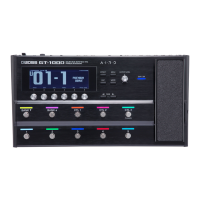
Do you have a question about the Boss GT-1000 and is the answer not in the manual?
| Sampling Frequency | 96 kHz |
|---|---|
| Patches | 250 (User) + 250 (Preset) |
| Effects | 116 types |
| MIDI | In, Out |
| Type | Multi-effects processor |
| Power Supply | AC Adaptor |
| Current Draw | 1.2 A |
| Display | Graphic LCD (512 x 160 dots, backlit LCD) |
| USB | USB Audio, USB MIDI |
| Dimensions | 462 mm x 248 mm x 70 mm |
| Weight | 3.6 kg |
| Looper | 38 seconds (mono), 19 seconds (stereo) |
| Nominal Input Level | -10 dBu |
| Input Impedance | 1 M ohm |
| Nominal Output Level | -10 dBu |
| Output Impedance | 1 k ohm |
| Dynamic Range | 110 dB or greater |
| Connectors | 1/4-inch phone type, XLR type |
| Inputs | 1/4-inch phone type |
| Outputs | 1/4-inch phone type |
Connects various components to the GT-1000, including input/output jacks.
How to choose and navigate between user and preset sound combinations.
Steps to enter effect editing mode and select effects for modification.
How to view and edit all parameters of a selected effect block simultaneously.
How to change the order or arrangement of effect blocks in the chain.
Detailed steps for moving effect blocks within the effect chain.
Techniques for seamless patch changes to avoid audio interruptions.
How to edit the parameters of saved STOMPBOX effect settings.
Recalling saved STOMPBOX settings into the current patch.
Saving current patch settings as a STOMPBOX.
General navigation and operation within the GT-1000's menu system.
Customizing which parameters are controlled by the unit's knobs on the play screen.
Restoring the unit to its original factory settings, optionally selecting specific items.
Instructions for downloading and installing the necessary USB driver for computer connectivity.
Specific warnings and precautions to prevent damage or injury.
General important notes regarding placement, repairs, and data handling.
